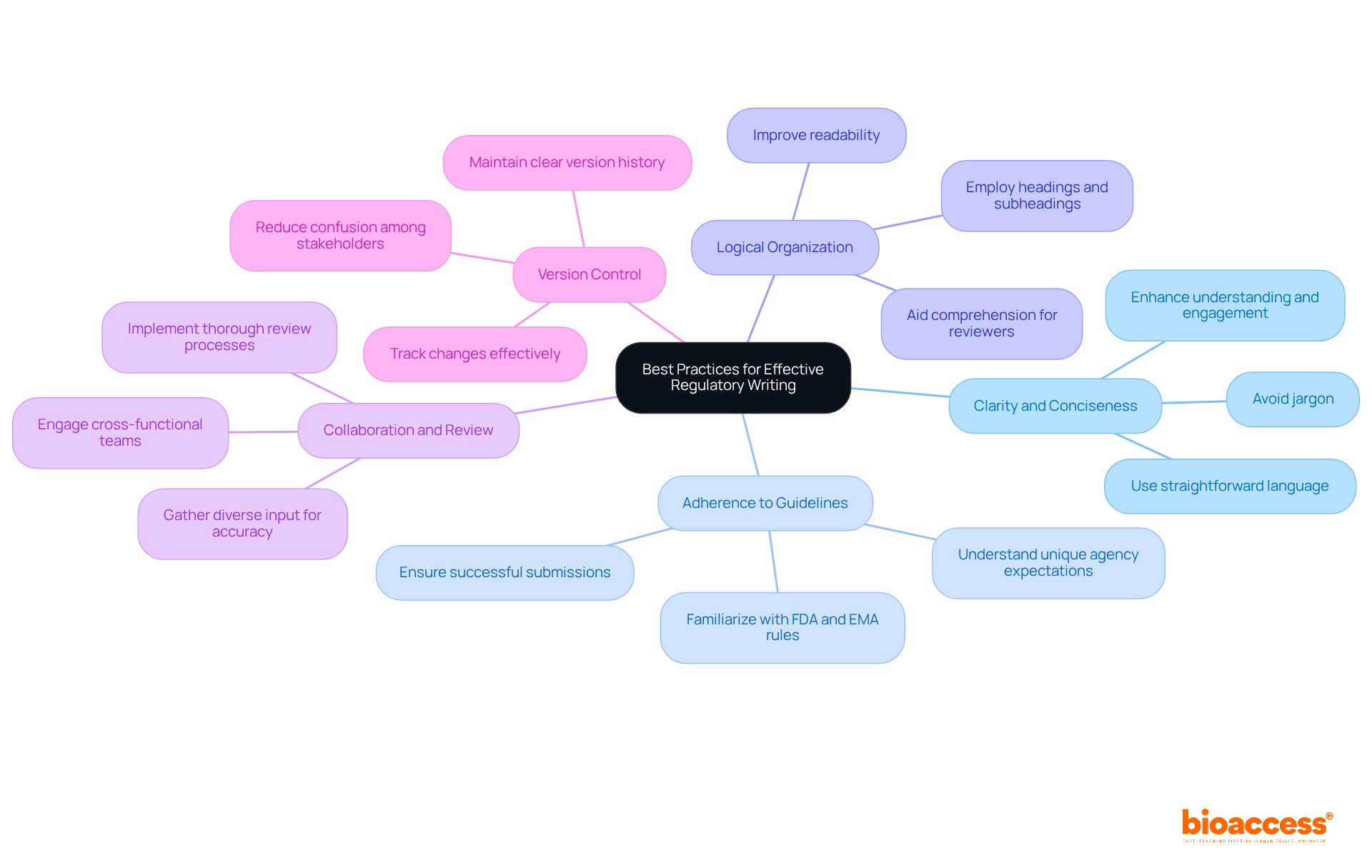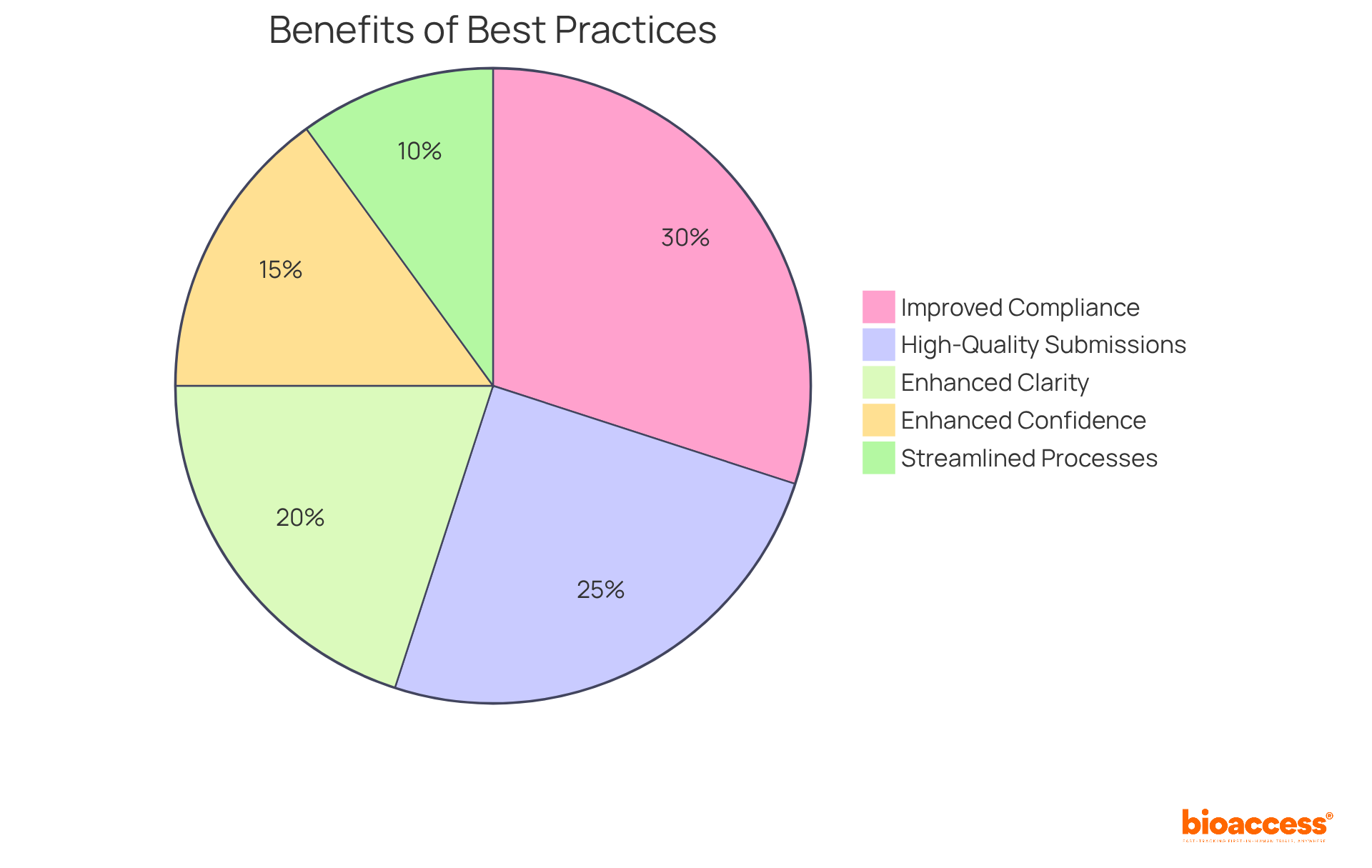


The article highlights best practices for successful clinical trial regulatory writing, a critical component for ensuring clear communication and compliance in medical research. Clarity is paramount; it not only facilitates understanding but also aligns with regulatory guidelines. Adherence to these guidelines, coupled with logical organization, fosters collaboration and effective version control. These practices are not merely procedural; they lead to improved compliance, faster approval times, and enhanced trust among stakeholders.
In the evolving Medtech landscape, the role of bioaccess becomes increasingly significant in addressing key challenges faced in clinical research. By implementing these best practices, organizations can navigate the complexities of regulatory writing more effectively. This proactive approach not only streamlines processes but also positions stakeholders for success in their clinical endeavors.
In conclusion, the importance of collaboration cannot be overstated. As the landscape of clinical research continues to evolve, embracing these best practices will be essential for fostering trust and achieving regulatory success. Stakeholders are encouraged to assess their current practices and consider how these insights can be integrated into their workflows.
The complex realm of clinical trials relies heavily on a crucial yet frequently overlooked element: regulatory writing. As the backbone of compliance documentation, effective regulatory writing guarantees that vital information regarding medical research is conveyed clearly and accurately to oversight bodies. This article delves into essential best practices that not only improve the quality of regulatory documents but also streamline the approval process, ultimately influencing the success of clinical trials. Given the high stakes involved, what strategies can organizations adopt to navigate the intricacies of regulatory writing while steering clear of the pitfalls that could delay or derail their research efforts?
The creation of essential materials for the authorization and oversight of medical research by governing bodies is a critical aspect of clinical trial regulatory communication. This encompasses a variety of documents, including:
The primary objective of compliance documentation is to convey all necessary information clearly and precisely, enabling oversight organizations to efficiently assess the safety and effectiveness of medical products. In 2025, the global compliance documentation market was valued at approximately USD 1.34 billion, with projections indicating growth to USD 3.30 billion by 2031, reflecting a compound annual growth rate (CAGR) of 10.5%.
Effective compliance documentation adheres to stringent guidelines in the context of clinical trial regulatory requirements while translating complex scientific information into formats that are accessible to various stakeholders, such as authorities, researchers, and ethics committees. Successful examples of compliance writing illustrate the ability to navigate evolving guidelines and maintain meticulous attention to detail, which is vital in preventing delays or rejections of drug applications. As the landscape of medical research continues to evolve, the demand for skilled compliance writers who can bridge scientific advancement and clinical trial regulatory requirements is more crucial than ever.
At bioaccess®, our expertise in compliance navigation and tailored solutions for Medtech startups ensures that we deliver expedited research outcomes, facilitating a smoother path to approval and market entry. How can we assist you in overcoming the challenges of clinical research compliance?

Key regulatory documents in clinical trial regulatory processes are essential for ensuring compliance and effective management of trials. Understanding these documents is crucial for clinical research leaders navigating the complexities of the field.
Clinical Study Protocol: This foundational text outlines the study's objectives, design, methodology, statistical considerations, and organization. It serves as a blueprint for the trial, ensuring that all stakeholders grasp the study's framework and requirements.
Informed Consent Form (ICF): The ICF plays a vital role in participant engagement, ensuring individuals are fully informed about the study's risks, benefits, and procedures before consenting to participate. Notably, approximately 75.8% of participants understand their freedom to withdraw at any time, underscoring the importance of clear communication in these forms.
Clinical Study Report (CSR): This comprehensive document summarizes the study's methodology, results, and conclusions, providing a detailed account of the trial's findings. The CSR is essential for compliance submissions, capturing the actual study procedures and outcomes to ensure adherence to standards.
Investigator's Brochure (IB): The IB contains all relevant information about the investigational product, including preclinical and clinical data. It informs investigators and ethics committees about the product's safety and efficacy, facilitating informed decision-making.
Submission Materials: These materials consist of requests for Investigational New Drug (IND) status or New Drug Applications (NDA), presented to oversight agencies for authorization to conduct trials or sell products. The precision and thoroughness of these submissions are vital for successful authorization.
Comprehending these crucial records and their elements is vital for clinical research leaders to effectively manage the intricacies of clinical trial regulatory compliance.

To achieve effective regulatory writing, consider the following best practices:
Clarity and Conciseness: Utilize straightforward language to convey complex information effectively. Avoid jargon and ensure that the material remains accessible to all stakeholders, enhancing understanding and engagement.
Adherence to Guidelines: Familiarize yourself with the specific rules set by relevant authorities, such as the FDA and EMA. Understanding these clinical trial regulatory guidelines is crucial for achieving successful submissions and approvals, as each agency may have unique expectations that must be met.
Logical Organization: Structure documents logically, employing headings and subheadings to guide readers through the content. This organization not only improves readability but also aids in comprehension, making it easier for reviewers to navigate the material.
Collaboration and Review: Engage with cross-functional teams, including clinical and legal experts, to gather diverse input and ensure accuracy. For instance, experts like Ana Criado, Director of Compliance and a professor with extensive experience in biomedical engineering and health economics, exemplify the kind of knowledge that can enhance compliance documentation. Her collaboration with international firms has led to improved compliance writing practices, underscoring the importance of varied perspectives in identifying potential errors and bolstering the reliability of the content. Implementing a thorough review process helps identify errors and enhances the overall quality of the documentation.
Version Control: Maintain a clear version history of files to track changes effectively. This practice ensures that all stakeholders are working from the most current version, reducing confusion and streamlining the review process. Recognizing the significance of version control can prevent miscommunication and ensure that all team members are aligned.
By concentrating on these optimal methods, technical writers can significantly enhance the clarity and effectiveness of their documents, ultimately facilitating quicker approval times and improved outcomes in research trials.

Adopting best practices in regulatory writing offers significant advantages for clinical trials:
Improved compliance with clinical trial regulatory guidelines minimizes the risk of non-compliance, which can lead to delays or costly penalties. Statistics indicate that organizations with strong compliance frameworks experience up to 30% fewer delays in approval processes.
Enhanced Clarity: Clear and concise documentation fosters better understanding among stakeholders, facilitating efficient communication and collaboration throughout the clinical trial process. This clarity is crucial for aligning expectations and responsibilities.
High-quality submissions are more likely to be accepted without extensive revisions, resulting in quicker approval times in the clinical trial regulatory process from oversight agencies. Studies reveal that well-prepared submissions can reduce approval timelines in clinical trial regulatory processes by as much as 25%.
Enhanced confidence in the clinical trial regulatory framework is built by regularly creating transparent and compliant materials, fostering trust with oversight bodies, ethics committees, and study participants. This trust is essential for the successful execution of trials, as it encourages cooperation and transparency.
Streamlined Processes: Implementing best practices leads to more efficient workflows, minimizing the time and resources needed to prepare and submit compliance paperwork. Organizations prioritizing regulatory writing best practices often report a 40% reduction in document preparation time, allowing teams to focus on critical trial activities.

Mastering regulatory writing in clinical trials is not just essential; it’s a cornerstone for ensuring that medical research adheres to stringent guidelines and effectively communicates critical information. This practice not only facilitates a smoother approval process but also fosters trust among stakeholders, including oversight bodies and study participants. As the demand for skilled regulatory writers continues to rise, grasping the nuances of this field becomes increasingly vital.
This article has outlined the significance of key regulatory documents—clinical study protocols, informed consent forms, and clinical study reports—emphasizing their roles in compliance and effective trial management. Best practices in regulatory writing, from clarity and adherence to guidelines to collaboration and version control, are crucial for enhancing the quality and efficiency of submissions. By implementing these strategies, organizations can significantly reduce approval timelines and improve overall trial outcomes.
Ultimately, the impact of effective regulatory writing on clinical trials cannot be overstated. It streamlines processes and builds confidence in the regulatory framework, paving the way for successful research endeavors. Embracing best practices in regulatory writing is not merely a necessity; it represents a strategic advantage that can lead to more efficient clinical trials and contribute to advancements in medical science.
What is regulatory writing in clinical trials?
Regulatory writing in clinical trials involves creating essential materials for the authorization and oversight of medical research, including clinical study protocols, informed consent forms, and clinical study reports.
What is the primary objective of compliance documentation in clinical trials?
The primary objective of compliance documentation is to convey all necessary information clearly and precisely, enabling oversight organizations to efficiently assess the safety and effectiveness of medical products.
What was the value of the global compliance documentation market in 2025, and what are the projections for 2031?
In 2025, the global compliance documentation market was valued at approximately USD 1.34 billion, with projections indicating growth to USD 3.30 billion by 2031, reflecting a compound annual growth rate (CAGR) of 10.5%.
Why is effective compliance documentation important in clinical trials?
Effective compliance documentation is important because it adheres to stringent guidelines and translates complex scientific information into accessible formats for various stakeholders, which helps prevent delays or rejections of drug applications.
What skills are essential for compliance writers in the context of clinical trials?
Compliance writers must possess the ability to navigate evolving guidelines and maintain meticulous attention to detail, which is vital for bridging scientific advancement and regulatory requirements.
How does bioaccess® assist Medtech startups with clinical research compliance?
Bioaccess® provides expertise in compliance navigation and tailored solutions, ensuring expedited research outcomes and facilitating a smoother path to approval and market entry for Medtech startups.